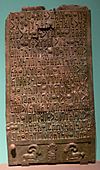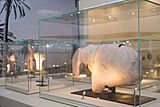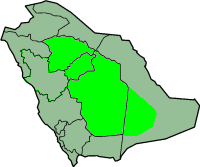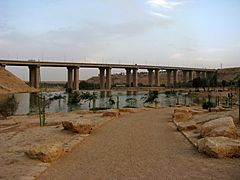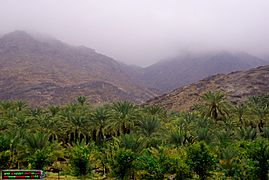Najd facts for kids
Quick facts for kids
Najd
نَجْدٌ
|
|
|---|---|
|
Region
|
|
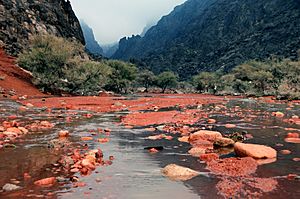
Landscape of the Shammar Mountains range
|
|
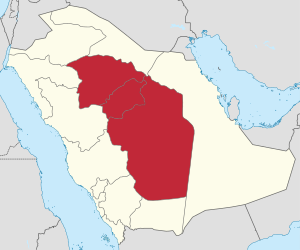
Map of the Najd region in Saudi Arabia
|
|
| Country | |
| Regions | Riyadh, Al-Qassim, Ha'il |
Najd (Arabic: نَجْدٌ) is a large central region in Saudi Arabia. It makes up about one-third of the country's population today. For a long time, Najd has been important for uniting the Arabian Peninsula. The House of Saud, Saudi Arabia's royal family, started their efforts to bring Arabia together from this region.
Historically, Najd was split into three main areas. These areas are still used today. The Riyadh region is home to Wadi Hanifa and the Tuwaiq mountains. It includes Riyadh, the capital city of Saudi Arabia since 1824. Another part is the Sudair region, with its capital in Majmaah.
The second main area is Al-Qassim. This region has many fertile oases and date palm farms. It is located along Wadi Rummah in central Najd. Its capital is Buraidah, the second largest city in Najd. This area was often fought over by the Rashidi dynasty from the north and the House of Saud from the east and south.
The third area is Ḥaʼil in the north. It features the Shammar Mountains and is home to Ḥaʼil, the capital of the Tayy tribe.
Contents
History of Najd
Ancient Times
The Najd region is home to Al-Magar, a very old culture from the Neolithic period. This culture was in southwestern Najd. Al-Magar might be one of the first places where people started farming and taming animals, especially horses. This happened before the climate changed and the area became a desert. Scientists have found objects at Al-Magar that are about 9,000 years old.
In 2017, hunting scenes were found in Shuwaymis, southwest of Ha'il. These paintings show what look like domesticated dogs with leashes. They are about 8,000 years old and are thought to be the oldest pictures of dogs in the world.
In ancient times, many tribes lived in Najd. These included the Kindites and Tayy. Around 115 CE, the Tayy tribe moved from Yemen and took over the Shammar Mountains. The Tayy Shammaris became nomadic camel herders and horse breeders. A part of the tribe settled in Ha'il, which became their capital.
In the 5th century AD, northern Arab tribes threatened trade routes. The Himyarite Kingdom decided to set up a kingdom to control central and northern Arabia. The Kindites grew strong enough for this role. In 425 AD, the Himyarite king made Hujr 'Akīl al-Murār the first King of Kindah. They formed the Kingdom of Kinda in central Arabia. Their first capital was Qaryat Dhāt Kāhil, now called Qaryat al-Fāw.
The Ghassanids, Lakhmids, and Kindites were all important kingdoms in Najd. In the 5th and 6th centuries, the Kindites tried to unite all the tribes of Central Arabia. They fought wars with the Lakhmids. Their most famous king, Al-Ḥārith ibn 'Amr, captured the Lakhmid capital of al-Ḥirah in modern-day Iraq. But later, in 529, al-Mundhir recaptured the city and killed King Ḥārith.
In 525, the Aksumites invaded Himyar, which weakened the Kindites. Their kingdom split into four groups. These small kingdoms were later overthrown in the 530s and 540s. In 540, the Lakhmids destroyed Kindite settlements in Najd. This forced most of them to move to Yemen. Many Arab tribes then allied with the Lakhmids.
The Era of Muhammad
During the time of Muhammad, military expeditions took place in Najd. The first was the Nejd Caravan Raid in 624. Muhammad's followers successfully raided a caravan belonging to the Quraysh tribe. They captured valuable goods.
The Invasion of Nejd happened in October 625 AD. Muhammad led his fighters to Najd to deter tribes he believed had hostile plans. Some historians say the Expedition of Dhat al-Riqa was part of this invasion. However, others believe it happened later, after the Battle of Khaybar.
The Expedition of Qatan also took place in Najd. The Banu Asad ibn Khuzaymah tribe was powerful and connected to the Quraysh. They lived near Katan in Najd. Muhammad heard they were planning to raid Medina. So, he sent 150 men under Abu Salama 'Abd Allah ibn 'Abd al-Asad to surprise the tribe.
After Muhammad's Time
Ridda Wars
After Muhammad's death, some tribes in Arabia rebelled against Medina. Some leaders claimed to be prophets, like Musaylima in Yamamah and Tulayha in north-central Arabia. Malik ibn Nuweira led the Banu Tamim tribe in Najd against Medina's authority.
Abu Bakr became the first caliph (leader) of the Muslim community. He sent armies to bring these rebellious tribes back under control. Khalid ibn al-Walid was a key general. He defeated Tulayha in the Battle of Buzakha in September 632. He also defeated other rebel tribes in Najd.
Khalid then moved to Najd against the Banu Tamim tribe and their leader, Malik ibn Nuwayrah. Many Banu Tamim clans submitted to Khalid. However, Malik ibn Nuwayrah did not. Malik was accused of rebellion and of making a pact with another prophetess, Sajjah. Khalid ordered Malik's execution.
Another general, Ikrimah ibn Abi-Jahl, was sent to Yamamah to confront Musaylima. Ikrimah attacked too early and was defeated. Abu Bakr then sent Khalid to Yamamah. Khalid joined forces with other Muslim armies. In December 632, their combined force of 13,000 soldiers defeated Musaylima's army in the Battle of Yamama. After this victory, all of central Arabia submitted to Medina. The remaining rebellions in other parts of Arabia were put down within five months.
Later Centuries
After these wars, Muhammad's followers quickly expanded Muslim rule. They conquered large areas from Spain to modern-day Pakistan. Many tribes from Najd helped in this expansion. They became important governors and leaders in the new Muslim empire.
Najd then became less important politically as the focus shifted to the newly conquered lands. Many conquering tribes from Najd moved to other regions like the Levant, Persia, and North Africa.
16th Century to Saudi Unification
In the 16th century, the Ottoman Empire took control of the Red Sea and Persian Gulf coasts. They also claimed power over the interior of Arabia. However, their control varied over time.
The Al Saud royal family began in Najd in 1744. Their leader, Muhammad bin Saud, joined with a religious leader named Muhammad ibn Abd al-Wahhab. He founded the Wahhabi movement, a strict form of Sunni Islam. This alliance helped the Saudis expand their power.
The first "Saudi state" grew quickly and controlled most of present-day Saudi Arabia. But it was destroyed by the Ottoman governor of Egypt in 1818. A smaller second "Saudi state" was formed in Najd in 1824 by Turki bin Abdallah. For the rest of the 19th century, the Al Saud fought for control with another ruling family, the Rashidi dynasty. By 1891, the Al Rashid won, and the Al Saud went into exile in Kuwait.
In 1902, Ibn Saud, a son of Abdul Rahman, recaptured Riyadh. This brought the Al Saud back to Najd. Ibn Saud gained support from the Ikhwan, a tribal army inspired by Wahhabism. With their help, he captured al-Ahsa from the Ottomans in 1913.
During World War I, the Ottoman Empire was weakened. In 1916, the Sharif of Mecca, Hussein bin Ali, led an Arab Revolt against the Ottomans. This revolt aimed to create a united Arab state. Although it didn't fully succeed, the Allied victory in the war ended Ottoman rule in Arabia.
Ibn Saud focused on fighting the Al Rashid. After defeating them, he became the Sultan of Najd in 1921. With the Ikhwan's help, he conquered the Hejaz region in 1924–25. In 1926, he declared himself King of the Hejaz. A year later, he added the title King of Nejd.
After conquering the Hejaz, the Ikhwan wanted to expand into British-controlled areas like Jordan, Iraq, and Kuwait. Ibn Saud disagreed, as he wanted to avoid conflict with the British. The Ikhwan also disliked Ibn Saud's modernizing policies. They turned against him and were defeated in the Battle of Sabilla in 1930. Their leaders were killed. In 1932, the two kingdoms of Hejaz and Najd were united to form the Kingdom of Saudi Arabia.
Geography of Najd
Boundaries
The Arabic word najd means "upland." It was once used for many regions in the Arabian Peninsula. Today, it mostly refers to the central region of the Peninsula. This area is bordered by mountains to the west and the historical region of Eastern Arabia to the east. To the north are Iraq and Syria.
Medieval geographers debated the exact borders of Najd. They generally set the western border where mountains sloped eastward. The eastern border was the Ad-Dahna Desert, a strip of red sand dunes. The southern border has always been the vast sand dunes of Rub' al Khali (the Empty Quarter).
The northern borders of Najd have changed a lot over time. In early Islamic centuries, Najd was thought to reach as far north as the River Euphrates. Today, the term Najd includes the region of Al-Yamama, which was not always part of it historically.
Topography
Najd is a plateau that slopes from west to east. Its height ranges from about 762 to 1,525 meters (2,500 to 5,000 feet). The eastern parts, known as Al-Yamama, have many oasis settlements with farming and trade. The rest of the region was traditionally home to nomadic Bedouins.
Key features include the Shammar Mountains in the north near Ha'il. The Tuwaiq mountain range runs through the center from north to south. Important dry riverbeds, called wadis, are also found here. These include Wadi Hanifa near Riyadh, Wadi Na'am in the south, and Wadi al-Rummah in Al-Qassim. Most villages in Najd are located along these wadis or near oases. This is because wadis help save rainwater in the dry desert.
Historically, Najd was divided into smaller provinces. Each province had its own towns and villages, usually centered around a "capital." These areas still have their own unique Najdi dialects and customs. Some main provinces include Al-'Aridh (with Riyadh), Al-Qassim (with Buraidah), Sudair (with Al Majma'ah), Al-Washm (with Shaqraa), and Jebel Shammar (with Ha'il). Today, Saudi Arabia divides Najd into three administrative regions: Ha'il, Al-Qassim, and Riyadh. Together, they cover about 554,000 square kilometers (214,000 square miles).
Major Towns
Riyadh is the largest city in Najd and in Saudi Arabia. Its population was over 7.6 million in 2018. Other major cities include Ḥaʼil (over 936,000 in 2021) and Buraidah (over 745,000 in 2021). Smaller towns and villages include Unaizah, Ar Rass, Sudair, Al-Kharj, and Wadi ad-Dawasir.
Population of Najd
Social and Ethnic Groups
Before modern Saudi Arabia was formed, most of Najd's people were Arab tribes. Some were settled farmers and merchants living in towns and villages. Others were nomadic Bedouins, who moved between towns. There were also Arabs not linked to any tribe, who worked in trades like carpentry. A small number of African and European slaves and freed people also lived there.
Most Najdi tribes came from Northern Arabia, Tihamah, and Hijaz in ancient times. Famous ancient tribes included Banu Hanifa (around Riyadh), Banu Tamim (further north), Banu Abs (in Al-Qassim), Tayy (around Ha'il), and Banu 'Amir (in southern Najd).
From the 15th to 18th centuries, more tribes moved into Najd. This increased both the nomadic and settled populations. Many ancient tribes changed over time or moved from other parts of the Middle East. However, most native Najdis today still belong to these old tribes or their newer groups. The Saudi royal family, Al Saud, traces its family line to Banu Hanifa.
In the early 20th century, major nomadic tribes included Dawasir, Mutayr, 'Utaybah, Shammar, Subay', Suhool, Harb, and the Qahtanites. Many settled people belonged to Anizzah, Banu Tamim, and Banu Hanifa.
Today, most nomadic tribes have settled in cities like Riyadh or in special settlements called hijras. These settlements were created in the early 1900s to end nomadic life. Very few nomads remain in the Kingdom now.
Since modern Saudi Arabia was formed, many people from all over the country and from other countries have moved to Najd, especially Riyadh. Many native Najdis have also moved from their villages to Riyadh.
About a quarter of Najd's population are non-Saudi workers. These include skilled professionals and laborers. Slavery was ended in Saudi Arabia in 1962. Some freed slaves chose to keep working for their former owners.
Unlike the Hejaz and Tihamah regions, Najd was remote. It stayed outside the control of large Islamic empires like the Abbasids and the Ottoman Empire. This isolation helped shape its unique culture.
Religion
Najd is known for its strong Hanbali Islamic traditions. After the 18th century, it became known for a strict interpretation of Islam. The founder of Salafism, Muhammad ibn Abd al-Wahhab, was born in 'Uyayna, a village in Najd.
Most people in the region consider themselves Salafi Muslims. Salafism means returning to the traditions of the "ancestors" (salaf). These ancestors are the first three generations of Muslims, including Prophet Muhammad and his companions. Salafis believe Muslims should follow the Qur'an, the Sunnah (teachings of Muhammad), and the consensus of these early Muslims.
Language
People in Najd have spoken Arabic for almost all of recorded history. Like other parts of the Peninsula, there are differences between the dialect of nomadic Bedouins and settled townspeople. However, these differences are less noticeable in Najd. The Najdi town dialect seems to have come from the Bedouin dialect. Many settled Najdis are also descendants of nomadic Bedouins.
Some believe the Najdi dialect is the least influenced by other languages. This is because of Najd's isolated location and harsh climate. Even the ancient South Arabian language does not seem to have been widely spoken in Najd.
Within Najd, different regions and towns have their own accents and sub-dialects. But recently, these have started to blend together. They are also influenced by Arabic dialects from other regions and countries, especially in Riyadh.
Economy
In the early 20th century, Najd produced coarse wool cloth. It also had a wide range of farm products. Today, agriculture, oil, and services are important to its economy.
See also
 In Spanish: Néyed para niños
In Spanish: Néyed para niños
- Hadith of Najd
- History of Saudi Arabia
- Kingdom of Nejd and Hejaz
- List of expeditions of Muhammad in Nejd
- Nejd Expedition


